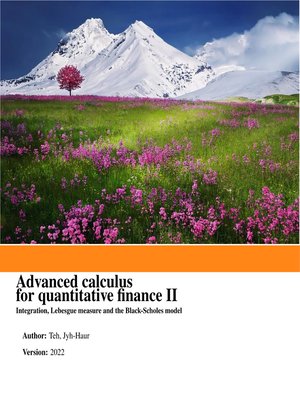Advanced calculus for quantitative finance II
ebook ∣ Integration, Lebesgue measure and the Black-Scholes model
By Jyh Haur Teh

Sign up to save your library
With an OverDrive account, you can save your favorite libraries for at-a-glance information about availability. Find out more about OverDrive accounts.
Find this title in Libby, the library reading app by OverDrive.



Search for a digital library with this title
Title found at these libraries:
| Library Name | Distance |
|---|---|
| Loading... |
Advanced calculus occupies the most fundamental position in mathematics training. It is an essential path from elementary numerical calculation to higher-level abstract thinking. Mathematical knowledge and the ability of abstract thinking become more and more important in modern sciences and technology industries. Quantitative finance is a perfect field for showing the power of mathematics.
In our opinion, advanced calculus for students in quantitative finance should not be the same as the one for students in mathematics department since they have different training in mathematics and different kinds of applications in future studies.
Based on lecture notes for the advanced calculus courses that the author taught in the National Tsing Hua University of Taiwan for students from the department of quantitative finance, the author produces two books: Advanced calculus for quantitative finance I & II. The goal of these books is to introduce mathematical analysis and provide background behind the Black-Scholes model in options.
The Black-Scholes model and its variants are probably the most common models in finance. Since even an introduction of mathematical Brownian motion is out of the reach of undergraduate mathematics, it is not easy to talk about Ito calculus which the Black-Scholes model lies on. The author takes up the challenge in these books. The goal is to provide deep mathematics for students in quantitative finance and at the same time show them such mathematics is tightly related to their field of studying.
Differences between these books and advanced calculus textbooks for students in mathematics are that they start from a lighter mathematics prerequisites, skip some results such as the inverse function theorem that are not directly related to the study of mathematical finance, introduce probability theory based on Lebesgue integration, provide basic stochastic calculus, give a rather rigor derivation of the Black-Scholes model, introduce Fourier transform
to solve the heat equation, and use it to derive a solution for the Black-Scholes equation.
Each of these two books contains 3 midterm exams and 1 final exam, accompany with a practice exam before each examination. Also at the end of each section, there are some exercises for students to get familiar with the materials. Proofs of some more difficult theorems are provided in the appendix of each section.







